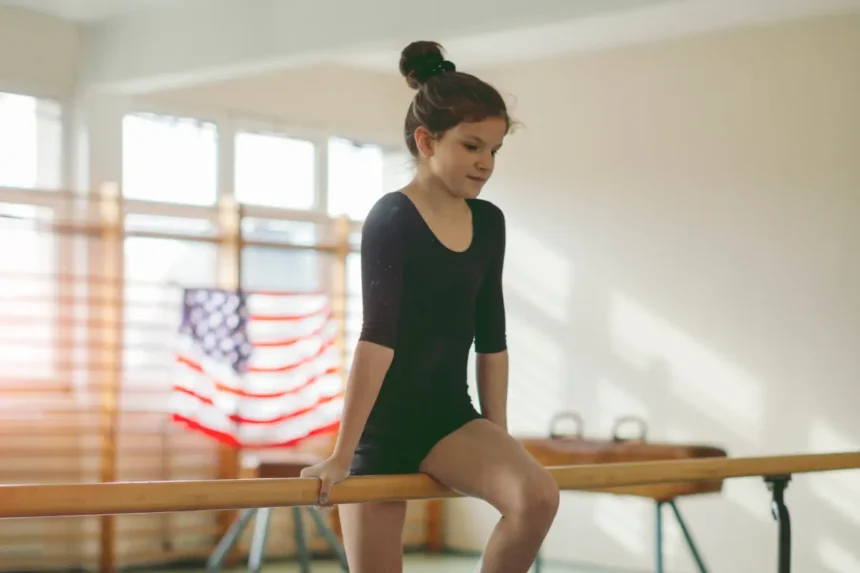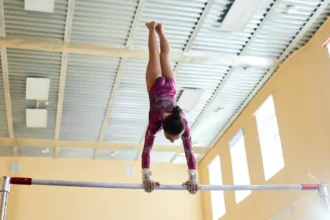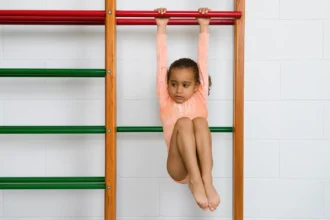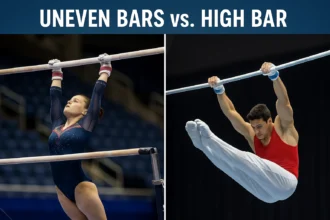Bar work in gymnastics takes a mix of upper-body strength, core stability, control, and coordination. To nail skills like casts, kips, giants, and dismounts, gymnasts need focused conditioning that builds the strength, endurance, and technique to succeed.
What Is Bar Conditioning in Gymnastics?
Bar conditioning is a focused series of exercises, drills, and strength routines designed to prepare gymnasts for the demands of the gymnastics bar apparatus—uneven bars for women, high bar and parallel bars for men. These routines target:
- Upper-body strength (shoulders, arms, back)
- Core stability (abdominals, lower back, hip flexors)
- Grip endurance
- Shoulder and wrist mobility
- Body shape control (hollow, arch, tuck, and pike positions)
Consistent bar conditioning doesn’t just improve skill execution—it reduces injury risk and builds the confidence needed to perform complex sequences.
Below are seven key drills every gymnast can incorporate into their conditioning program.
1. Pull-Ups (Overhand and Underhand)
Pull-ups are a staple for building lat, bicep, forearm, and shoulder strength. Practicing both overhand and underhand grips ensures balanced muscle development and grip versatility.
Why This Drill Matters:
Pull-ups are the base for almost every bar skill that involves pulling—like kips, casts, and clear-hips. A strong pull allows you to lift your body efficiently and connect movements without wasting energy.
How to Perform
- Starting Position: Hang from the bar with arms fully extended. Use an overhand grip (palms away) slightly wider than shoulder-width or an underhand grip (palms toward you) at shoulder-width or narrower.
- Engagement: Pull shoulders down and away from ears.
- Pull: Exhale as you lift your chin to bar level, elbows close to your torso.
- Lower: Inhale as you lower with control, avoiding a hard lockout.
Tips & Progressions
- Beginner: Use a resistance band or assisted pull-up machine.
- Intermediate: Pause at the top of each rep.
- Advanced: Add weight or perform slow negatives.
2. Piked Leg Lifts (Toes to Bar)
This core-intensive drill builds the abdominal compression needed for bar skills while improving control.
Why This Drill Matters:
The piked position is key in kips, stalder entries, and toe-on skills. Strong compression allows you to lift your hips and legs efficiently without swinging out of control.
How to Perform
- Hang from the Bar: Overhand grip, arms straight, shoulders active.
- Lift Legs: Keep legs straight and lift to hip level (pike). Progress to touching toes to the bar.
- Lower with Control: Resist swinging and return to the starting position slowly.
Tips & Progressions
- Beginner: Start with knee lifts.
- Advanced: Add a pause at the top or slow the tempo.
3. Tucked Pull-Ups (Hollow Position)
This variation strengthens the upper body while training core engagement for more complex bar skills.
Why This Drill Matters:
Combining a pull with a hollow tuck simulates the body position during kips, muscle-ups, and certain releases, teaching you to generate lift while holding proper shape.
How to Perform
- Grip: Hang from the bar with hands shoulder-width apart.
- Tuck: Draw knees toward your chest, maintaining a hollow body.
- Pull: Lift your chin to the bar.
- Descend: Lower slowly, staying tucked.
Tips & Progressions
- Beginner: Use a block or band for assistance.
- Advanced: Hold at the top or slow the lowering phase to 3–5 seconds.
4. Leg Shoot-Ups (Single & Double)
Great for developing the hip drive and arm pull essential for kips and bar transitions.
Why This Drill Matters:
Shoot-ups mimic the explosive upward movement needed to bring your hips to the bar—critical for kips, straddle-ups, and cast handstands.
How to Perform
- Setup: Use a low bar or stand on a block under a high bar.
- Single-Leg Version: Hook one knee over the bar and drive the free leg and hips upward.
- Double-Leg Version: Hook both legs over and explosively shoot hips toward the bar.
- Return: Lower under control to avoid swinging.
Tips & Progressions
- Beginner: Start with single-leg shoot-ups.
- Advanced: Land directly in front support or cast position.
5. Tucked Rocks (Toes to Bar)
A dynamic drill for rhythm, control, and smooth transitions like kips or baby giants.
Why This Drill Matters:
The rocking motion trains your ability to keep tension and control momentum—skills needed for linking bar elements without breaking form.
How to Perform
- Starting Hang: Overhand grip, hollow body.
- Tuck & Lift: Bring knees toward the chest or toes toward the bar.
- Rock: Swing slightly forward, then tuck again in a continuous motion.
Tips & Progressions
- Beginner: Work on small knee tucks.
- Advanced: Aim to tap toes to the bar every rep.
6. Bent Arm Hand Grasp Changes
Trains stability and grip-switching ability for mid-skill transitions.
Why This Drill Matters:
Many bar skills require grip changes mid-movement—like clear-hip to front support or giant to inbar. This drill builds the strength and control to switch without losing position.
How to Perform
- Partial Pull-Up: Hold yourself in a bent-arm position (~90°).
- Switch One Hand: Change grip from overhand to underhand.
- Switch Other Hand: Return to balanced position.
Tips & Progressions
- Beginner: Focus on quick, controlled transitions.
- Advanced: Hold at varied arm angles for more challenge.
7. Hollow Body Hold on Bar
A strong hollow is essential for swings, casts, and giants.
Why This Drill Matters:
Every high-quality bar routine relies on shape control. A strong hollow position keeps swings clean, improves tap timing, and prevents form deductions.
How to Perform
- Hang from Bar: Overhand grip, shoulder-width apart.
- Hollow Position: Round upper back slightly, draw ribs in, and lift legs forward with a tucked pelvis.
- Hold: Keep the entire body stable and tight.
Tips & Progressions
- Beginner: Start with 5–10 second holds.
- Advanced: Extend arms by ears and legs straight, or add small leg lifts.
Bar Conditioning Drill-to-Skill Connection
| Drill | Primary Skills Supported | Key Benefits |
|---|---|---|
| Pull-Ups (Overhand & Underhand) | Kips, casts, clear-hips, giants | Builds pulling strength and grip endurance |
| Piked Leg Lifts (Toes to Bar) | Toe-on skills, stalder entries, pike dismounts | Improves core compression and body control |
| Tucked Pull-Ups (Hollow Position) | Kips, muscle-ups, release moves | Combines pulling power with shape maintenance |
| Leg Shoot-Ups (Single & Double) | Kips, straddle-ups, cast handstands | Develops explosive hip drive and upward momentum |
| Tucked Rocks (Toes to Bar) | Kips, baby giants, swing rhythm control | Trains controlled momentum and dynamic core strength |
| Bent Arm Hand Grasp Changes | Clear-hip to front support, giant to inbar grip changes | Improves mid-skill grip changes and shoulder stability |
| Hollow Body Hold on Bar | Swings, giants, casts, tap timing | Enhances body shape control and prevents form deductions |
Doing these drills regularly will make you stronger, more stable, and in better control on the bars. With time, they’ll lead to cleaner skills, longer endurance, and more confident routines.






